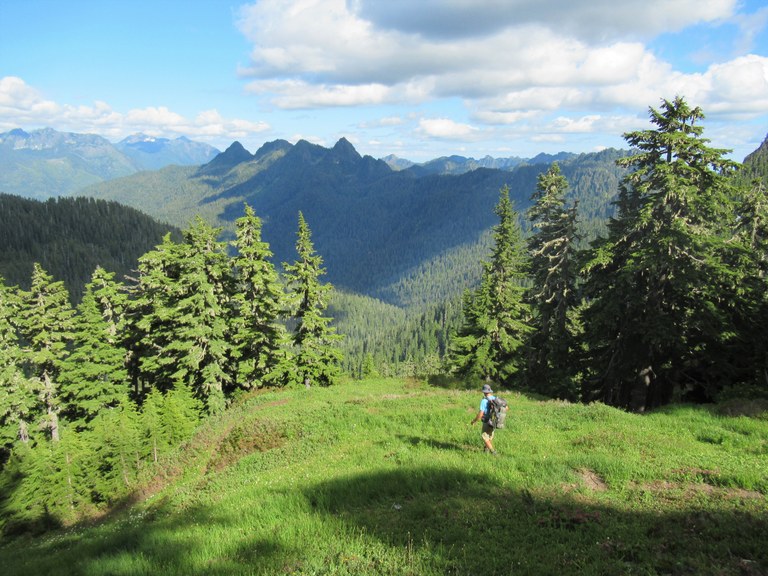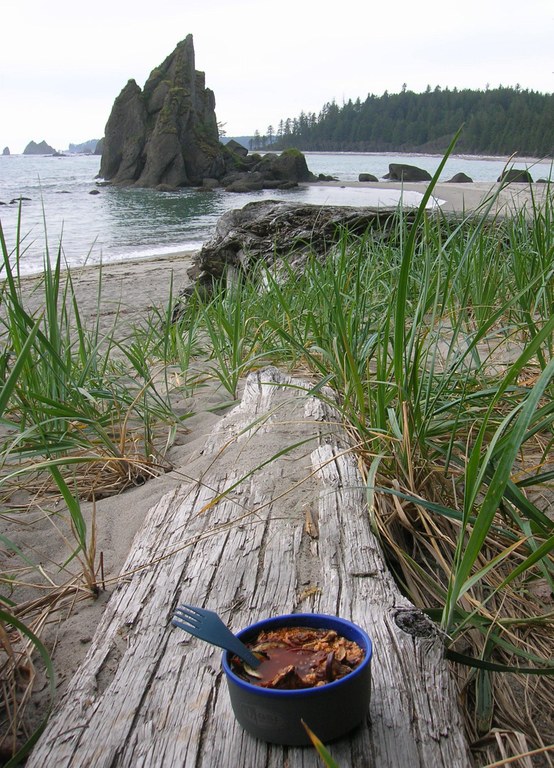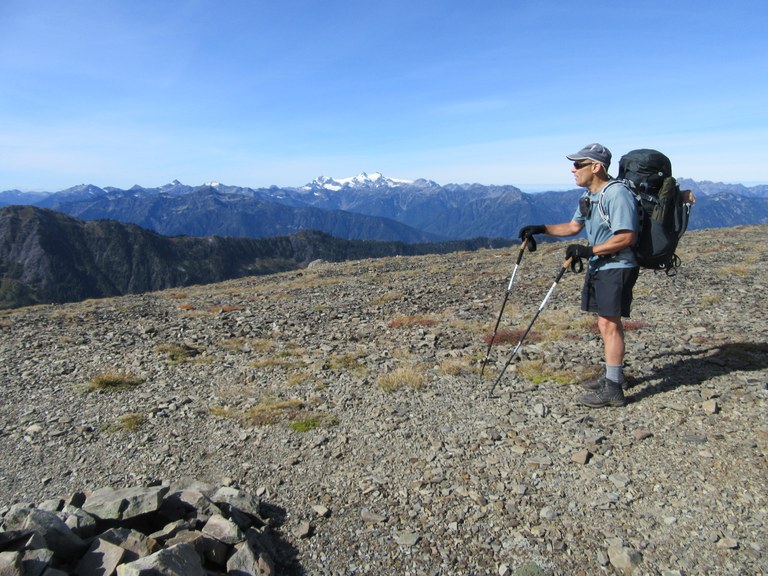 Washington Trails
Association
Washington Trails
Association
Trails for everyone, forever
What to consider before you head out for backpacking adventures this summer. | By Craig Romano
In all my years and miles on trail, I’ve experienced countless memorable moments with stunning vistas, amazing wildlife encounters and profound spiritual and existential enlightenment. But some of my fondest experiences involved schlepping a full pack deep into the wilderness and setting up camp for an evening — or several — far away from the distractions of the modern world.
From a camp beside a fjord in Chilean Patagonia, I witnessed the magnitude of a glacier calving. In Quebec’s Chic-Choc Mountains, I arose before sunrise to watch the southernmost caribou herd in North America feast upon alpine tundra. And closer to home, in Olympic National Park’s Seven Lakes Basin, a young coyote visited my site and a lone marmot whistled taps from his rock perch against a blood-red sky. It was a wonderful culmination to a day that also included bugling elk and a black bear sow and cub splashing in an alpine lake.
I wouldn’t have experienced any of these incredible events if out for a single day. Backpacking allows you to take hiking up a notch and to experience the outdoors in a whole different way. If you’re one of my regular readers, you know that I thrive on pushing myself by covering long distances on trail. When I backpack, I like to cover distances that I couldn’t do in a day — or give myself the time to explore an area more deeply than if I just traveled through it on a day hike or trail run.

I know that there are many hikers who enjoy setting up backcountry camps on short excursions. I also understand that there are lots of short-distance backpacking destinations that are amazing places and allow for a night in the wilderness without too much effort. And I know that we all have physical limitations and that hiking far into the wilderness is not an option for everyone. And someday (sooner than I would like) I will have to face that reality as well.
But for those of you who are experienced backpackers and would like to go farther into the wilderness, this article is for you. I would like to share some of my planning methods and hacks for an amazing backpacking experience.
Get out the guidebooks, peruse the maps, read the trip reports and Hiking Guide and start piquing your interest for what possibilities are out there. Do you want a quick getaway from the city? If so just know your possibilities for solitude are going to be more limited. The same applies if your backpacking plans include epic hikes in popular wilderness areas or national parks, which may also require planning for permits. If it’s possible for you to go on weekdays and shoulder seasons, you may see fewer other people and find it easier to get permits. And while a hiker early- or late-season may have weather challenges, it can have bonuses as well, such as the beauty of a landscape under new snowfall or a raging cascade where there is normally only a mediocre waterfall.
Zero in on the area you’re interested in backpacking, and then decide what type of trip interests you. Do you like the challenge of covering great distances by hiking with a full pack each day, setting up camp and then repeating the process? Or do you like to hike far into the backcountry, set up camp and then do day excursions from your established basecamp? Both methods have their appeal. Generally, I enjoy the latter for shorter trips — busting my hump to get to a remote location and then enjoying short day hikes from my camp. But the appeal of going even farther into the backcountry or covering long-distance trails is fun too, and you eventually get into the rhythm. The method you choose will help you narrow in on what trails you should consider in your general area.
When to go: Once you’ve decided on an area, it’s time to look at logistics. Are there seasonal concerns such as dangerous snow crossings, wildlife management closures or potentially dangerous fords? Be sure to take these into consideration when you make your plans. Consider other factors too, such as areas that are normally quiet except during key hunting seasons — or stretches of the Pacific Crest Trail that go from lonely to bustling once thru-hikers begin arriving.
What to consider about permits: If you need permits for your destination, you’ll want to secure them as soon as possible. But if you’re like me and you like to plan your hikes by the weather or other factors that don’t allow for planning far ahead, areas that require reservations for camping aren’t going to cut it. For these areas you have three options if you don’t want to try to get a limited permit: Do that hike when reservations aren’t necessary, plan on seeing that area as a long day hike or run, or find a suitable substitute area.

For instance, instead of dealing with the challenges of trying to get an Enchantments permit, seek out similar regions that are less popular. Instead of the Enchantments, consider the Chiwaukum Mountains. Instead of Olympic National Park’s High Divide, where permits are in high demand, consider a stretch on the Skyline Trail, where a permit is much easier to secure. Instead of the Ozette Triangle (permits limited), head to Toleak Point (no permit limits). Instead of North Cascades National Park’s Copper Ridge (limited permits), consider just about anywhere in the Pasayten Wilderness (no limits).
If you want solitude: There are many less-visited areas that rival the popular places when it comes to exceptional scenery. Skip Spider Meadow and head up Rock Creek. Explore the north side of Mount Adams instead of Indian Heaven Wilderness. Hike Six Ridge in Olympic National Park instead of Flapjack Lakes. And allot some time to get to less-visited places such as the North Fork of the Entiat River Valley, southeastern Washington’s Wenaha-Tucannon Wilderness and northeastern Washington’s Kettle River Range, Thirteenmile Canyon and Salmo-Priest Wilderness. Wherever you’re going, permit or not, remember to follow Leave No Trace principles.
Include your bike in your plans: Another tip for off-the-beaten-path backpacking destinations involves using your mountain bike. Look for road closures leading to great destinations. Most hikers will be dissuaded by a long road walk. So use your bike to cover those long road miles (and enjoy the probably downhill ride on the way out). Bike Mount Rainier’s Westside Road, and Klapatche Park and Sunset Park become much shorter backpacking destinations. Take advantage of the Elwha River road closure and enjoy backpacking to Boulder Lake, Happy Lake and other destinations.
Think about how much you pack: Hopefully, the more you backpack, the more wisdom you’ll gain on how to make your trips better. Things that I’ve learned along the way include thoroughly assessing everything you plan on putting in your pack and carrying on your back. Is it really necessary? Going as light as possible while still maintaining enough comfort at camp will make the biggest difference on whether you can tear up the miles or will be suffering along the way. Pack your pack and go for a trial walk around the neighborhood. Can you comfortably travel for long distances over rugged terrain with that load?
Simple cooking, lighter pack: All my meals and coffee involve one step — boiling water! I bring one cup, one bowl and one tiny pan on my trips, as well as my tiny pocket rocket stove. Meal preparation is simple — pour boiling water over dehydrated food. I don’t want to mess around. Clean up is simple, too. I also pack dehydrated soups on every trip. They help keep me hydrated, which is so important.

Camp comfort: What are some of my must-haves for backpacking that make a difference for camp comfort? I pack a collapsible 3-liter water bucket that allows me to make only one trip to retrieve water each day. This is especially handy when the water source is a long way from camp. I carry a special bladder for wine for my evening nightcap. I also pack a lightweight, collapsible solar-powered light. It is comforting to have light at camp (especially during autumn’s long nights) and great to have a lit tent for reading, finding gear and making your way back to the tent after a nighttime call of nature.
Where to camp: When I set up camp, I consider these points. First, remember to camp in established sites or on durable surfaces. I generally look for sites in open forest groves near a meadow edge. This gives me protection from rain and wind and ample light from the forest opening. Check drainage patterns — you don’t want to wake up in a pool if a storm passes by. When it’s hot, I seek a site in a ravine where air cooled by cold rushing water creates a cool breeze — and more than likely keeps the bugs down, too. When I need to stay warm, I avoid areas that have the potential for an inversion and prolonged shading. I set up camp on higher ground with a southern exposure, so warming sunlight hits me longer and cool air won’t settle near me.
Borrow good ideas: Perhaps the best thing I’ve learned along the way is to watch what others are doing. Everyone has their own hacks and must-have gizmos. They may work for you too. Have fun experimenting with new things.
Happy backpacking!
Craig Romano is the author of more than 25 guidebooks, including “Backpacking Washington,” second edition (Mountaineers Books).